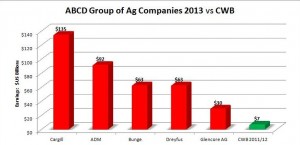(August 3, 2016) Last week’s effective closure of the port of Churchill as a grain shipping port and likely a rail-based adventure tourist destination marks another sad milestone in the transformation of the western grain economy. In spite of assurances from the Western Grain Elevators Association (WGEA) that they have lots of handling capacity at Thunder Bay to offset the loss of Churchill; the closure darkens the future of Thunder Bay as well.
The WGEA say they represent companies handling “in excess of 90% of western Canada’s bulk grain exports.” But if you cut through the corporate jungle, aside from a handful of comparatively tiny Canadian companies their membership is really the foreign giants of the ABCD group that effectively run the rest of the world’s grain trade. By claiming that the real issue is handling capacity the WGEA is diverting attention away from both the killing of the Wheat Board being the primary cause of the closing of Churchill and the fact Churchill was a smaller competitor.
Of course it is true WGEA’s members have lots of handling capacity elsewhere and are building more. However it is also true that for those farmers in the Churchill catchment area the WGEA facilities cost more to use. Their next nearest port is Thunder Bay.
In light of the Western Grain Elevators Association assurances, it is fair to ask how long it will be before Thunder Bay suffers the same fate as the port of Churchill?
Like the OmniTrax terminal at Churchill, the Mission terminal at Thunder Bay is not really owned by the largest ABCD group members. Glencore’s Viterra terminal and the two Richardson terminals at Thunder Bay are also small players compared to the west coast ports or even the deep water ports along the St. Lawrence river.
So how soon will it be before the big players of the ABCD group choose to bypass another small competitor? After all closing just one or two of the larger Thunder Bay terminals would go a long way to making the remaining facilities too small to carry the costs of moving grain through the St. Lawrence Seaway system.
For the larger players with terminals on the St. Lawrence River at Baie Comeau, Port Cartier, and Quebec City, sending whatever grain is needed for the Atlantic market via rail to these deep water ports on the St. Lawrence River must be a tempting option especially since they can lower their fixed overhead costs by abandoning Thunder Bay and any extra operating costs will be paid by farmers.
The process of abandoning Canada’s long standing quality-assured grain export system with its focus on high-end niche markets around the world is pretty much complete. It started with the 2011 killing of the Canadian Wheat Board which ended the democratic influence of farmers on this system. Without the single-desk Wheat Board, the formerly Canadian controlled system is largely controlled by the same four giant companies (known as the “ABCD” group) that run the rest of the world’s grain production.
As was said here, the port of Churchill was all about providing value to the farmers in its catchment area of eastern Saskatchewan and Manitoba. However, without the Wheat Board, the system is absolutely not about producing value for farmers. Now the system is about profits for the ABCD group.
What’s clear is that the closing of Churchill is one of the many shoes that have dropped since Harper and company killed the Wheat Board and there are more to come. It would be no surprise if Thunder Bay was next.



